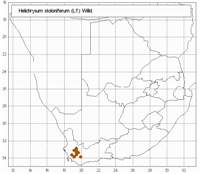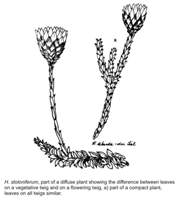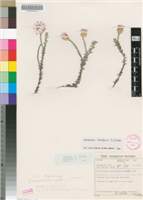Common names:
Ankerbossie (A)
Diagnostic characters:
Large solitary headsWhite bracts with pink tips; outer bracts golden-brown
Description:
Subshrub, main stems up to c. 300 mm long, branched, prostrate or diffuse, flowering branchlets ascending, all closely leafy throughout. Leaves imbricate, those on sterile shoots mostly 7�15 x 2�6 mm, subequal, narrowly obovate, lower part appressed, webbed to stem, upper part ascending or spreading, often somewhat recurved, tip acute, apiculate, hooked, leaves on flowering twigs often much narrower, c. 1,5�3 mm broad, somewhat spreading or strongly appressed, oblong-lanceolate or oblong, acute or subacute, uppermost often tipped with papery brown scales, all leaves wholly enveloped in silvery, silky 'tissue-paper' indumentum. Heads heterogamous, turbinate-campanulate, mostly 15�20 mm long, nearly double that across the radiating bracts, solitary at tips of branchlets in upper leaf axils, these branches penduncle-like when leaves much reduced and appressed. Involucral bracts in c. 7 series, loosely imbricate, graded, inner much exceeding flowers, linear-lanceolate, mostly subacute, sometimes acute, glossy white or pale to deep rose, or white tipped rose, outer ovate-lanceolate, subobtuse to acuminate, golden-brown sometimes tinged rose. Receptacle very shortly honeycombed. Flowers 58�282, 6�24 female, 52�243 homogamous. Achenes 1 mm long, cylindric, with myxogenic duplex hairs. Pappus bristles many, equaling corolla, tips subplumose, shaft scabrid, bases lightly fused.
Flowering between November and February.
Distribution:
Grows in rocky places, often rooted in rock crevices. On the mountains of the Western and Eastern Cape, from the Kamiesberg to the Cedarberg, Cold Bokkeveld Mountains, Winterberge, and the mountains around Worcester, Ceres, French Hoek and Genadendal with one record from the mountains near Murraysburg and another from Cave Mountain, Graaff-Reinet, always above 1 200 m.
Fynbos Biome.
Notes:
Closely allied to and much confused with H. retortum but that is a coarser plant confined to the coast. See also H. lancifolium.
The salient features of H. stoloniferum are the relatively small heads with generally bluntish inner involucral bracts. Plants may be compact (probably in response to hard growing conditions) and then the flowering twigs are short and there is little or no difference in size and form of leaves on sterile and flowering shoots. If the plants are well-grown and diffuse, there tends to be a marked difference between leaves on sterile shoots and those on flowering ones; the latter become pedunculoid with reduced, appressed, bract-like leaves. Schlechter 10095 (PRE), and Esterhuysen 3939 (PRE), both from the Koude Bokkeveld Tafelberg at 1 800 m, demonstrate this very well. This phenomenon is paralleled in other species e.g. Edmondia pinifolia.
Taxonomy:
Literature:
Helichrysum stoloniferum (L.f.) Willd., Sp. Pl. 3: 1907 (1804); Thunb., Fl. Cap. 662 (1823); Less., Syn. Comp. 291 (1832); Harv. in F.C. 3: 228 (1865), excl. Dr�ge spec.
Type:
Cape of Good Hope, Thunberg (990.24 LINN).
Synonym(s):
Xeranthemum stoloniferum L.f., Suppl. 366 (1781). Gnaphalium stoloniferum (L.f.) Sch. Bip. in Bot. Ztg 3: 169 (1845).
Argyrocome retorta sensu Cass. in Dict. Sci. nat. 34: 39 (1825), non (L.) Gaertn.
Helichrysum retortum var. minus DC., Prodr. 6: 178 (1838); Harv. in F.C. 3: 228 (1865). Lectotype: Cape, Kamiesberge, Dr�ge 2834 (G-DC).
Vouchers:
Compton 12855 (NBG); Esterhuysen 1421 (BOL); Galpin 12585 (PRE); Schlechter 10041 (BM; G; PRE); Stokoe in SAM 68368 (SAM; PRE).


